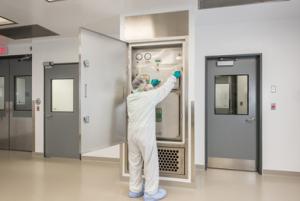The life sciences industry affects our lives – every day. Be it a diagnostic test, a prescription medicine, or even treatments for animals, we all benefit from advances.
With the increasing demand for products from our aging population, public investment is at all-time high– $1 billion in investment is forecast over the next ten years in Massachusetts alone. This industry, which formerly had plenty of options for leasable space, is actively seeking new opportunities for growth. Consigli is working on life science projects throughout the Northeast, including new development, renovations of existing buildings and tenant fit-outs.
We recently completed one such project for ImmuCell, a Maine-based animal health medicine manufacturer. We served as the construction manager to expand their Portland headquarters with a new, 16,000 SF cGMP facility for the production of a new biologic treatment of a common infection found in cows worldwide.
Immucell’s existing facility housed products regulated by the USDA; this new product requires more stringent FDA approval. The company decided to build a new facility for the product that would include space for fermentation, laboratory, processing and a storage warehouse.
As with the development of any new product, an aggressive schedule was required to have the facility up and running so they could adhere to their planned schedule for regulatory approvals; meaning the build-out had to happen over the course of 11 months.
Some of the steps taken to meet this challenging construction schedule include:
Construction began before design was complete. The cGMP facility was built in two phases. The first phase was the construction of the core and shell. This process began in September of 2016, and completing as much as possible before winter set in was a priority. The second phase was the fit-out, which focused on installation of production equipment and support space customized to the treatment’s unique manufacturing process. The fast-track construction schedule included major bid packages, such as high purity process piping and process control valves and automation, as well as long lead process-related equipment.
- Down-to-the-minute site coordination. To ensure there was no man-hour waste on the project, detailed coordination on site was of utmost importance. Our team utilized a number of tools and processes to expedite on-site activities:
- Technology. Utilizing BIM and 3D technologies ensured our team in the field would be able to get everything that needed to be in the space to fit as anticipated, such as making sure utilities that ran to work and lab stations fit above ceilings.
- Materials verification. When building cGMP facilities, the successful execution of the project hinges on the accountability of the team for verifying every material brought on site. In an environment where even the smallest particle can disrupt the manufacturing and fermentation process, our standard operating procedures are essential to the operation of the facility post-construction.
- Limited materials on site. Once materials were verified, there was a finely tuned schedule for materials to arrive on site so they wouldn’t be in the way of workers who needed to easily move between rooms during the fit-out stage. We also employed a “nothing hits the ground” strategy; any materials brought on site were on a cart or pallet so they could be picked up with a pallet jack or easily moved.
- Coordination between vendors and the trades. LEAN practices were used to coordinate the significant amount of coordination that must happen with vendors installing equipment, as well as between the trades. MEP contractors shared a platform staging system to ensure pipes, conduit, and ductwork installation was as efficient as possible. We did pull planning for all trades, where the foreman coordinated in each space so the next trade could begin.
The opportunity to be part of the growth and the development of companies behind pioneering research, innovative solutions and lifesaving cures, allows us to contribute to progress each and every day.
 Consigli is constantly researching ways to make the construction process more efficient; from worker productivity to technological innovation. We recently embarked on a study of the daily protocols required by our workers in clean room environments; from entering the building through gowning up and other protocols. This data shows that almost one-fifth of a worker’s day can be spent on maintaining protocols; so we’re finding new ways we can minimize the time it takes our workers to begin daily tasks in clean room environments while still adhering to strict guidelines…thereby maximizing progress and reducing project schedules in the process.
Consigli is constantly researching ways to make the construction process more efficient; from worker productivity to technological innovation. We recently embarked on a study of the daily protocols required by our workers in clean room environments; from entering the building through gowning up and other protocols. This data shows that almost one-fifth of a worker’s day can be spent on maintaining protocols; so we’re finding new ways we can minimize the time it takes our workers to begin daily tasks in clean room environments while still adhering to strict guidelines…thereby maximizing progress and reducing project schedules in the process.
